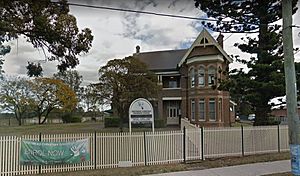Essington, Westmead facts for kids
Quick facts for kids Essington |
|
|---|---|
 |
|
| Location | 2, 4, 6, 8 Bridge Road, Westmead, Cumberland Council, New South Wales, Australia |
| Built | 1860–1890 |
| Owner | Church of the Foursquare Gospel |
| Official name: Essington; Essington Christian Centre; Essington Christian Academy | |
| Type | State heritage (complex / group) |
| Designated | 2 April 1999 |
| Reference no. | 204 |
| Type | House |
| Category | Residential buildings (private) |
| Lua error in Module:Location_map at line 420: attempt to index field 'wikibase' (a nil value). | |
Essington is a special historic place in Westmead, Australia. It used to be a large home and farm owned by a wealthy man. Today, it is an independent school called the Essington Christian Centre.
The building was constructed between 1860 and 1890. It is located at 2, 4, 6, and 8 Bridge Road. The Church of the Foursquare Gospel now owns the property. Essington was added to the New South Wales State Heritage Register on 2 April 1999. This means it is an important historical site.
Contents
Essington's Story
Essington was built for William Fullagar, an important pioneer in the Holroyd area. It was his second home, built across the road from his first, called The Wattles. He wanted a grand house, and it was built with great care.
William Fullagar's parents were convicts, but he worked hard to become successful. He started as a butcher and publican. Then he became a stock agent, buying and selling animals. He bought a lot of land, becoming one of the biggest landowners in Holroyd.
In 1849, William Fullagar bought 30 acres (about 12 hectares) of land. He built his first home, Willow Cottage, there. He used his land for grazing cattle and growing crops. He also cut timber and made bricks.
By the 1870s, William Fullagar owned much of what is now Wentworthville. He continued his business but also wanted to live like a gentleman. He enjoyed fox hunts and was a good rider. He even helped manage Parramatta Park for a while.
His land, known as Fullagar's Paddock, was sometimes used by others. For example, students from Sydney Grammar School and The King's School once camped there in 1875.
William Fullagar moved into his new house, Essington, in the late 1880s. His wife, Sarah, passed away there in 1889. William himself died at Essington in 1894. After he died, parts of his large land holdings were sold off.
Around the 1920s, the verandah (a covered porch) on the house was changed.
In the 1980s, the Four Square Gospel Church in Parramatta bought Essington. In 1982, they put up a new picket fence. Since 1983, the church has used the site as a primary school. They have also bought nearby houses to help the school grow.
What Essington Looks Like
Essington is a large, two-storey historic house. It stands on a raised area at the corner of Bridge Road and the Great Western Highway. This makes it easy to see in the area.
The original house was built in a style that mixes Victorian and Federation designs. It has an L-shape with gabled roofs. The walls are made of different coloured bricks, and the roof is made of slate. There are special bay windows with sandstone sills.
The original verandah was replaced later, probably between the two World Wars. This new verandah has two storeys with brick columns. Over the years, more parts have been added to the house. These additions include single-storey and two-storey sections.
In 1990, four new classrooms were built on the western side of the house. There is also a large car park on the north side. An auditorium, a large hall for events, is located further north on the property.
Changes to Essington
Essington has seen several changes over the years:
- In 1982, major repairs and updates were done. This included fixing the staircase, replacing window cords, and restoring marble fireplaces.
- Also in 1982, a new picket fence was put up along Bridge Road and the Great Western Highway.
- In 1990, four new classrooms were built on the west side of the house.
- In 2003, a large old gum tree was removed from the northern side of the house.
- In 2005, the slate roof was repaired.
Why Essington is Important
Essington is important because of its connection to the Fullagar family. They were a very important family in the early days of Holroyd. The property was once part of a large government area that William Fullagar bought around 1860. The house itself was built by another family member later on.
The house and its grounds also show us what large, grand homes looked like in the Holroyd area in the 1800s and early 1900s. Even though some parts have been changed, Essington still represents a specific style of architecture from that time.
Essington was officially listed on the New South Wales State Heritage Register on 2 April 1999. This listing helps protect its historical value for future generations.

